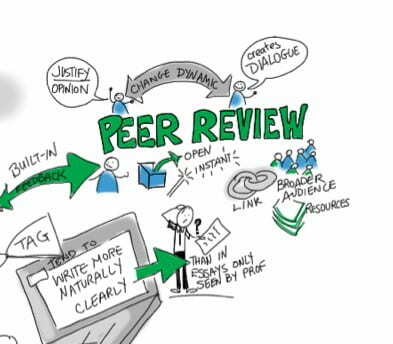e-Learning Ecologies MOOC’s Updates
Peer review
Recursive feedback is very crucial to learning and this concept has been quite well reinforced by our course facilitators. Peer review evaluates and validates academic work for their quality and originality by others working in the same field. Our course facilitator, Mary Kalantzis, says in ‘Recursive Feedback Part 4A’ that learners considerably improve their performance and understanding through peer feedback or review and final version of artefact is an improved version (Fig. 1). It has an important role in developing higher order thinking process.
The students can review the work of their peers at school or university level. Generally, a rubric is prepared by the instructor that defines the requirements and guides the students through the review process. In digital diverse media, peer reviews can be given regularly on YouTube, Twitter and other sites and it enriches the learning experience.
Fig. 1. Peer review. Accessed from http://sites.gsu.edu/cetlsotl/category/themed-clusters/giving-feedback-on-student-writing/
The certain advantages of peer review in course design and overall enriched experience are:
Design of Course: The course can be augmented by knowledge producers and the suggestions by the peer and experts can be accommodated [Cope and Kalantzis, 2017].
Assessment: Peer review has brough in new dimension and optimization in assessment. It has moved towards crowdsourcing and defining new learning modalities [Kalantzis and Cope, 2015].
Collaborative Intelligence: The review helps to create an updated version and builds collaborative Intelligence.
Knowledge creation: The regular feedback helps to create an improved writing. Huisman et al. [2019] studied the analysis of peer review on students’ academic writing in higher education. The study demonstrated that peer review resulted in considerable improvement in writing performance.
Peer interaction: It provides a positive environment for sharing and learning information.
Challenges of peer review if the system is automated [Haniya et al., 2019] are listed.
Creating a platform for learning and feedback could be a challenge.
Learning the tool could be initially intimidating.
It requires internet connection.
As a teacher and researcher, I am regularly engaged in publishing my research articles and review papers. Recently we had submitted our research work to be published in an esteemed peer-reviewed journal. Reviewers and Editor comments helped us to improve the manuscript tremendously and the final product was way improved in over all quality and clarity of data and figures. Thus, peer review plays a pivotal role in publishing quality work. Peer review is effective in improving the document.
References
Cope, B., and Kalantzis, M. (2017). Conceptualizing e-learning. In B. Cope and M. Kalantzis (Eds), e-Learning Ecologies. New York: Routledge.
Haniya, S., Tzirides, A.O., Matthew Montebello, M., Georgiadou, K., Cope, B., and Mary Kalantzis, M. (2019) Maximizing Learning Potential with Multimodality: A Case Study. World Journal of Educational Research. Vol. 6, No. 2, pp. 2333-5998 (Online) www.scholink.org/ojs/index.php/wjer
Huisman, B., Saab, N., van den Broek, P., and van Driel, J. (2019) The impact of formative peer feedback on higher education students’ academic writing: a Meta-Analysis, Assessment & Evaluation in Higher Education, Vol. 44, No.6, pp. 863-880. DOI: 10.1080/02602938.2018.1545896
Kalantzis, M., and Cope, B. (2015). Learning and new media. In D. Scott and E. Hargreaves (Eds.), The sage handbook of learning (pp. 373-387). Thousand Oaks CA: Sage.


